Gustave
Eiffel’s first work: the Eiffel passerelle, Bordeaux 
a
dream unfulfilled - the transporter bridge [pont transbordeur],
Bordeaux 
a
fifth bridge coming to Bordeaux: pont Chaban-Delmas, a new vertical
lift bridge 
the
6th bridge at Rouen: Pont Gustave Flaubert,
new vertical
lift bridge
Ile
de France, Paris: in the context of Abelard and of French cathedrals 
France’s western isles: Ile de Ré
France’s
western iles: Ile d’Oleron
Marianne
- a French national symbol, with French definitive stamps
the
calendar of the French Revolution

la
belle époque 
Grand
Palais, Paris
Pic
du Midi - observing stars clearly, A64 
Carcassonne,
A61: world heritage fortified city 
Futuroscope
Vulcania
Space
City, Toulouse
the
French umbrella & Aurillac
50
years old: Citroën DS
the
Citroën 2CV:
a
French motoring icon |
The damage was not more serious because the Cathedral architect
and the Department of Historic Monuments took protective measures.
As early as 1915, the doorways of the western façade were
protected with beams and banks of sandbags, while the Treasure,
paintings and tapestries were removed and placed in safety. From
1916, masonry protections were placed around some of the more
valuable statues. Fallen fragments of carvings and sculpture were
carefully collected, ready for future restoration. Thus, was the
debris of the head of the “Smile of Reims” saved.
At
the beginning of 1918, it was found possible to save the remains
of the window stained-glass, as well as other still intact glass-work.
The salvage was difficult as scaffolding would have given the
Germans further excuses for bombardments. Instead, a small body
of Paris firemen and two glaziers were employed. During foggy
weather and before daybreak, they climbed up to the iron framework
of the windows and accomplished their work with remarkable courage
and skill.
The
Smile of Reims
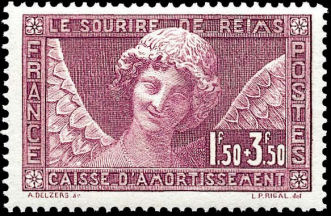
The Smile of Reims
stamp, issued in March 1930
Thus is named one of the amazingly sculpted statues that
line the doorways to the cathedral on its West facade.
The happy face is renowned, though sometimes confused
with another statue called the Smiling Angel that stands
not far away.
The Smile of Reims is the angel alongside Saint Nicaise
closest to the doorway, located at the north
side of the north portal of the west facade.
The Smiling Angel is the Angel of the Annunciation - the
Archangel Gabriel - standing beside Mary, ‘Our Lady’.
These are to be seen on the south side of the central
portal of the west facade.
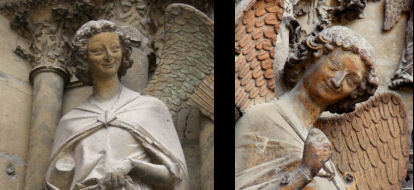
Left: the
Smile of Reims after restoration
Right: the Smiling Angel.
During the French
Revolution, the heads were knocked off the small statues lining
the doorways of the West facade [illustrated
just on the left]. However, the Revolutionaries couldn’t
bring themselves to smash the Smile of Reims.
Not so for
the invading Germans in 1914.
Reims was occupied by Germans
on 4 september 1914. German shelling was relentless. For instance,
between 14 and 19 September, the town of Reims was hit by up to
2,000 shells with 170 people being killed. The cathedral was hit
by between two to three hundred shells during WW1. (It is hard
to find accurate bombing and shelling numbers.)
“At about 15:00 on 19th September, a shell went through
the wooden scaffolding surrounding the north tower. The shell
exploded about halfway up and set the scaffolding on fire. Under
the great heat, half the rose window shattered, sparks spread
to the interior of the building and spread to straw beds laid
out inside for German wounded. At the same time, the oak roof
caught fire. The lead sheets covering the roof started to boil,
so a fine rain of lead fell into the interior of the cathedral.
On the exterior were veritable streams of lead running under the
vaults and out of the mouths of the gargoyles. It was no longer
possible to contain the fire. During the night, the Rémois
[inhabitants of Reims], beaten or furious, saw their cathedral
consumed.
“The efforts were in vain against this terrible
blaze. Abbés Thinot and Landrieux tried without success
to pull away the heavy beams of the scaffolding. In the town,
the rescue services were overwhelmed and powerless. The nearest
fire station had been destroyed by bombing, and firemen were dealing
with blazes throughout the town, in particular in the Wool Quarter,
and the water pipes had burst.
“This fire surprised
those watching because of its rapid progress. The first factor
enabling this was a violent wind. Then the staircase of the north
tower provided a strong draft which fanned the inferno of the
scaffolding. Finally, the cathedral stonework included a wide
variety of combustibles: straw strewn in the naves, chairs heaped
in the choir, the lateral columns [tambours] of the main
door (the columns had come from the old St Nicaise basilica).”
[translated from Naissance d’un mythe: L’Ange
au Sourire de Reims by Yann Harlaut, Editions Dominique
Guéniot]
Fire weakened the fabric of
the statues on the porches of the west facade, which started crumbling.
But one statue in particular suffered a shocking blow.
It
was Abbé Thinot who collected the twenty-odd pieces of
the head of the Smile of Reims, smashed by a falling beam from
wooden scaffolding, and then itself falling over four metres.
The scaffolding around the north tower had been set on fire by
the German shelling on the night of 19th September 1914. The remains
of the head were put in the cellar of the Archbishop, to be found
again more than a year later on 30th November 1915. After the
war had ended, with the help of a casting preserved in the Museum
of French Monuments, the head was pieced together and returned
to its angel in the West portal on 13th February 1926. |
The
Smile of Reims is located on the north side of the north
portal of the west facade.
The Smiling Angel is found on the south side of the central
portal on the west facade, part of the Annunciation group.
The Beau Dieu is on the central
dividing pillar of the east portal of the north facade
- the portal of the Last Judgment. This is a blind portal,
long walled up.
david
and goliath
I read about the carving of the story
of David and Goliath at Reims, but could not immediately locate
it on the exterior of the cathedral. Eventually, I found it way
way up on the west facade, above the rose window. It is very difficult
to see any detail without a telescope. After much searching, I
found a pre-World War One photograph where the carving appears.
Below is an enhanced version. Note the shadows from the deeply
carved relief.
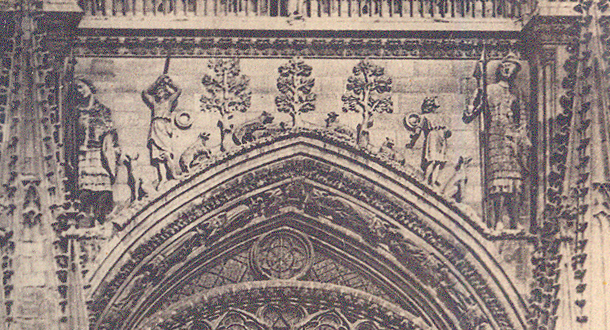
Far above the main porch of the west facade
on Reims cathedral,
showing David sling a stone at Goliath
[on right]
and beheading Goliath [on left]
The photograph below shows the effects of the German
bombardments. Even to this day, the statued frieze has
not been repaired - out of sight, out of mind. The Goliath
on the right has now been removed and put in the cathedral
museum in the Palais de Tau. The balustrade above has
been repaired.
The
Friends of the Cathedral are trying to raise money to restore
the Great Rose and surrounding statuary. If any visitor to Reims
Cathedral can take a good photograph of its present state, perhaps
they will let abelard.org use a copy.
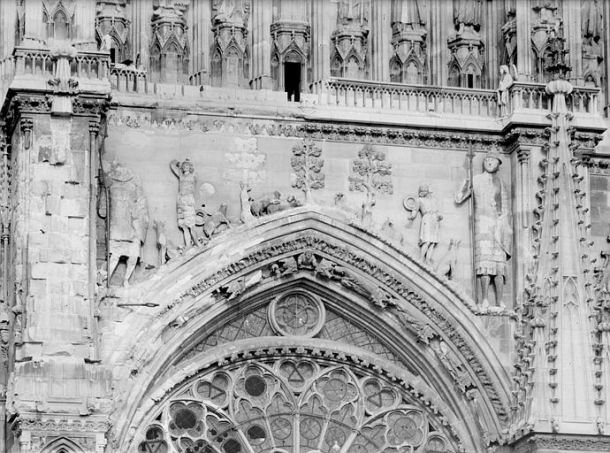
The same facade after the World War One bombardments.
Source: http://www.culture.gouv.fr
The Goliath statue on the right has since been removed to the
cathedral museum
the
labyrinth of reims cathedral
The Labyrinth of Reims
was built before the coronation of Philip the Fair [Philippe le
Bel], celebrated 6th January 1286, the work being directed by
Bernard de Soissons.
In the eighteenth century, children
and ‘idlers’amused themselves by following the lines
of the labyrinth, crisscrossing in every direction. The clergy,
in particular a certain Canon Jacquemart, disturbed by this game, decided to remedy the situation, in 1778 or 79,
by removing the labyrinth. An over-generous canon provided a thousand
pounds and the destruction completed without it being thought
to save the slightest piece of this precious monument.
Fortunately,
at the end of the previous century, Jacques Cellier had made a
detailed sketch of the labyrinth [placed in a manuscript collection
of the National Library, it was also reproduced in several archaeology
works] but without details of the legends accompanying the effigies.
However, there were two records made of those.
Pierre Cocquault,
canon of Reims who died in 1645, recorded the legends, in his
manuscript memoirs [a copy was put in the Reims town library].
The other recording of the legends was taken at the time of the
destruction, being published in a local daily paper, Affiches
rémoises dated 28 June 1779. Although the legends
to the labyrinths were deteriorating even in Cocquault’s
time, these two records together provide enough information to
know who the effigies represent.
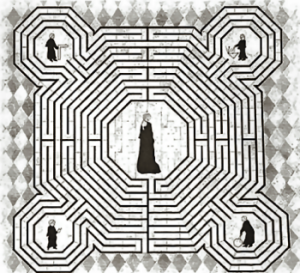
In
the centre is Archbishop Aubry de Humbert who laid the first stone
of the cathedral in 1211. The four smaller figures are the first
four masters of works [maître d’oeuvre].
Entering from the main west door:
- At bottom right:
Bernard of Soissons, maître d’oeuvre for
35 years, drawing a circle with a compass, because he ‘opened
the O’ - the west rose window.
- At bottom left: Gauche [Lefties] of Reims, master
during eight years, who ‘opened’ the arches
and doors. He held a pair of dividers.
- At top right: Jean d’Orbits who worked on the
nave and apse, which was finished in 1241. He held
a compass, one of whose points rests on a design.
- At top left: Jean Le Loup, master during
sixteen years, who also worked on the doors. He held a very large
square.
The labyrinth was certainly completed before the start
of the 14th century, as it does not include another of
the early maître d’oeuvre, Robert
de Coccyx, who died in 1311.
Labyrinths are still to be seen in the French cathedrals
of Chartres, Amiens, Reims, St.
Quentin, Sens, Saint-Omer and Toulouse (15th century).
Cathedrals were places of light and activity, a place
for townspeople to meet. They even had markets held in
the huge space of the nave. However, from the 18th century,
the puritanical fashions lead to the heart and life being
kicked out of the cathedrals, so they were no longer child
or fun friendly.
- related document:
- cathedral labyrinths and mazes in France


For the eight-hundredth anniversary of the cathedral’s
construction, the French Post Office - La
Poste - has issued a block of stamps with medieval
glass from Reims [below], while a
series of modern stained glass windows have been installed
in the cathedral.
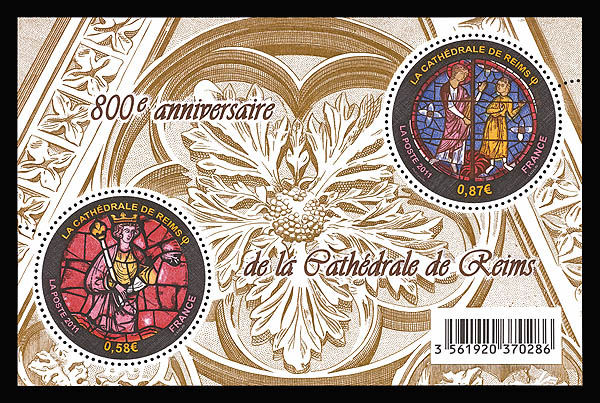
800th anniversary stamp block for
Reims cathedral
| Background
facts |
Reims 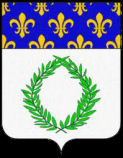 |
approximate
population : 196,565
average altitude/elevation : 83 m
- cathedral dimensions
- • exterior length : 149 m
• interior length : 138 m
• nave width : 14.65 m
• nave height : 38 m
|
bibliography
The cathedral of Reims, the story of a German crime
by the Right Reverend Monseigneur Maurice Landrieux, Bishop of Dijon
translated by Ernest E. Williams |
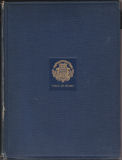 |
Regan Paul Trench, Trubner Co. Ltd, London
hbk, 1920 |
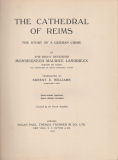 |
|
The gothic stained glass of Reims cathedral
by Meriedith Parsons Lillich |
 |
Pennsylvania State University Press, hbk, 2011
ISBN-10: 0271037776
ISBN-13: 978-0271037776
$47.96 [amazon.com]
£49.50 [amazon.co.uk] |
| A recent and excellent historical survey of the stained glass of Reims cathedral. |

- Some reference keywords/tags:
- cathedrale,france,germany,1870,1914,1940,invasion,occupation,cathedrale,Reims,Rheims,Emile
Brunet,Canada,St Gervais,St Protais,Smile of Reims,Smiling
Angel,l'Ange,le Sourire de Reims,
end
notes
- It was only in the early
11th century that Reims became the normal cathedral
for coronations of kings. Clovis, founder of the kingdom
of the Francs - the future France - was baptised at Reims in about 495 - the site was later incorporated
into the cathedral nave. Almost
all the kings of France were crowned at Reims from Louis
I the Pious [816] right up to Louis Philippe [1830].
Kings crowned elsewhere were Pépin le Bref (crowned
at both Soissons in 752 and St
Denis in 754), Louis VI le Gros (crowned at Orleans
in 1108), and Henry
IV (crowned at Chartres in 1594).
- The price of this stamp included
a 3.50 franc surtax to raise money for the restoration
of Reims cathedral. Probably for this reason, not many
of the stamps were sold and it is now scarce.
A more recent Smile of Reims stamp was issued in 1970:
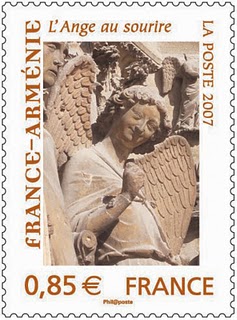
- Commonly, specialists,
when looking at the western (or any other) facade, refer
to the south portal on that facade as the left portal.
That is, describing it as viewed from the inside of
the church. On the other hand, most people will tend
to think of the church or cathedral from the outside
and refer to the same south portal of the west front
as the righthand portal.
Likewise, when viewing two statues alongside each other,
people will refer to ‘the statue on the left’
or ‘the statue on the right’. This is also
unclear because it is not certain whether what is being
referred to is the statue on the viewer’s lefthand
side, or a statue to the left hand of another statue.
Hence, I prefer to refer positioning in terms of north,
south, east and west. This is greatly simplified because
virtually all cathedrals and churches are oriented east-west.
- Emile Mâle, in
his work The religious art of the 13th century
in France [L’Art religieux au XIIIe
siècle en France] published in 1898, noted
that at Reims, “Saint Nicaise, the top of his
skull removed, marches with heroic serenity between
two angels who smile at him” [p.362].
There is often confusion as to whether there is one
or more Saint Nicaise, or which one is which. As you
can see on the left of both pictures, Saint Nicaise
has the top of his head missing. Now this, I believe,
is deliberate, not damage.
Saint Nicaise is one of the saints/martyrs who had his
head chopped off and then, as was common in those days,
picked it up and strolled into the nearest town, perhaps
performing a few miracles along the way, and maybe on
into his tomb. These saints are known by academics as cephalophores [head-carriers]. Saint Nicaise
was a very special cephalophore because only the top
part of his head was chopped off.
There is another, or is it the same, Saint Nicaise who
having rather naively and foolishly welcomed in the
Vandals, who attached him to a cart wheel before finishing
him off. The Rouelle of Saint Nicaise was a round stone dais that marked the place where he
was martyred, now replaced by a plaque.
- German shells during the first
world war included 12-in., 14-in. and 15-in shells.
| shell diameter |
range |
| 12 inch/30 cm |
6-7 miles |
| 14 inch/35 cm |
30 miles |
| 15 inch/ 38 cm |
24-26 miles |
A 14-inch shell would weigh approximately 850lbs/390kg.
These are fired from huge guns, whether cannon or mortars/howitzers.
They had originally been mounted of battleships. On
land, some were then mounted on trains, able to absorb
the heavy recoil by the gun carriage rolling about 100
yards along the line.
- From The Holy Bible:
King James Version, the First Book of Samuel, otherwise
called, the First Book of the Kings
Chapter 17
David Kills Goliath
- Now the Philistines gathered together their armies
to battle, and were gathered together at Shochoh,
which belongeth to Judah, and pitched between Shochoh
and Aze'kah, in Ephes–dam'mim.
- And Saul and the men of Israel were gathered
together, and pitched by the valley of Elah, and
set the battle in array against the Philistines.
- And the Philistines stood on a mountain on the
one side, and Israel stood on a mountain on the
other side: and there was a valley between them.
- And there went out a champion out of the camp
of the Philistines, named Goli'ath, of Gath, whose
height was six cubits and a span. [The
earliest texts apparently say four cubits and a
span, that is nearly 7 feet tall. Later writers,
enhancing the story, upped his height to nearly
10 feet tall.]
- And he had a helmet of brass upon his head, and
he was armed with a coat of mail; and the weight
of the coat was five thousand shekels of brass.
- And he had greaves of brass upon his legs, and
a target of brass between his shoulders.
- And the staff of his spear was like a weaver's
beam; and his spear's head weighed six hundred shekels
of iron: and one bearing a shield went before him.
- And he stood and cried unto the armies of Israel,
and said unto them, Why are ye come out to set your
battle in array? am not I a Philistine, and ye servants
to Saul? choose you a man for you, and let him come
down to me.
- If he be able to fight with me, and to kill me,
then will we be your servants: but if I prevail
against him, and kill him, then shall ye be our
servants, and serve us.
- And the Philistine said, I defy the armies of
Israel this day; give me a man, that we may fight
together.
- When Saul and all Israel heard those words of
the Philistine, they were dismayed, and greatly
afraid.
- Now David was the son of that Eph'rathite of
Beth–lehem–judah, whose name was Jesse;
and he had eight sons: and the man went among men
for an old man in the days of Saul.
- And the three eldest sons of Jesse went and followed
Saul to the battle: and the names of his three sons
that went to the battle were Eli'ab the firstborn,
and next unto him Abin'adab, and the third Shammah.
- And David was the youngest: and the three eldest
followed Saul.
- But David went and returned from Saul to feed
his father's sheep at Bethlehem.
- And the Philistine drew near morning and evening,
and presented himself forty days.
- And Jesse said unto David his son, Take now for
thy brethren an ephah of this parched corn, and
these ten loaves, and run to the camp to thy brethren;
- and carry these ten cheeses unto the captain
of their thousand, and look how thy brethren fare,
and take their pledge.
- Now Saul, and they, and all the men of Israel,
were in the valley of Elah, fighting with the Philistines.
- And David rose up early in the morning, and left
the sheep with a keeper, and took, and went, as
Jesse had commanded him; and he came to the trench,
as the host was going forth to the fight, and shouted
for the battle.
- For Israel and the Philistines had put the battle
in array, army against army.
- And David left his carriage in the hand of the
keeper of the carriage, and ran into the army, and
came and saluted his brethren.
- And as he talked with them, behold, there came
up the champion, the Philistine of Gath, Goli'ath
by name, out of the armies of the Philistines, and
spake according to the same words: and David heard
them.
- And all the men of Israel, when they saw the
man, fled from him, and were sore afraid.
- And the men of Israel said, Have ye seen this
man that is come up? surely to defy Israel is he
come up: and it shall be, that the man who killeth
him, the king will enrich him with great riches,
and will give him his daughter, and make his father's
house free in Israel.
- And David spake to the men that stood by him,
saying, What shall be done to the man that killeth
this Philistine, and taketh away the reproach from
Israel? for who is this uncircumcised Philistine,
that he should defy the armies of the living God?
- And the people answered him after this manner,
saying, So shall it be done to the man that killeth
him.
- And Eli'ab his eldest brother heard when he spake
unto the men; and Eli'ab's anger was kindled against
David, and he said, Why camest thou down hither?
and with whom hast thou left those few sheep in
the wilderness? I know thy pride, and the naughtiness
of thine heart; for thou art come down that thou
mightest see the battle.
- And David said, What have I now done? Is there
not a cause?
- And he turned from him toward another, and spake
after the same manner: and the people answered him
again after the former manner.
- And when the words were heard which David spake,
they rehearsed them before Saul: and he sent for
him.
- And David said to Saul, Let no man's heart fail
because of him; thy servant will go and fight with
this Philistine.
- And Saul said to David, Thou art not able to
go against this Philistine to fight with him: for
thou art but a youth, and he a man of war from his
youth.
- And David said unto Saul, Thy servant kept his
father's sheep, and there came a lion, and a bear,
and took a lamb out of the flock:
- and I went out after him, and smote him, and
delivered it out of his mouth: and when he arose
against me, I caught him by his beard, and smote
him, and slew him.
- Thy servant slew both the lion and the bear:
and this uncircumcised Philistine shall be as one
of them, seeing he hath defied the armies of the
living God.
- David said moreover, The LORD that delivered
me out of the paw of the lion, and out of the paw
of the bear, he will deliver me out of the hand
of this Philistine. And Saul said unto David, Go,
and the LORD be with thee.
- And Saul armed David with his armor, and he put
a helmet of brass upon his head; also he armed him
with a coat of mail.
- And David girded his sword upon his armor, and
he assayed to go; for he had not proved it. And
David said unto Saul, I cannot go with these; for
I have not proved them. And David put them off him.
- And he took his staff in his hand, and chose
him five smooth stones out of the brook, and put
them in a shepherd's bag which he had, even in a
scrip; and his sling was in his hand: and he drew
near to the Philistine.
- And the Philistine came on and drew near unto
David; and the man that bare the shield went before
him.
- And when the Philistine looked about, and saw
David, he disdained him: for he was but a youth,
and ruddy, and of a fair countenance.
- And the Philistine said unto David, Am I a dog,
that thou comest to me with staves? And the Philistine
cursed David by his gods.
- And the Philistine said to David, Come to me,
and I will give thy flesh unto the fowls of the
air, and to the beasts of the field.
- Then said David to the Philistine, Thou comest
to me with a sword, and with a spear, and with a
shield: but I come to thee in the name of the LORD
of hosts, the God of the armies of Israel, whom
thou hast defied.
- This day will the LORD deliver thee into mine
hand; and I will smite thee, and take thine head
from thee; and I will give the carcasses of the
host of the Philistines this day unto the fowls
of the air, and to the wild beasts of the earth;
that all the earth may know that there is a God
in Israel.
- And all this assembly shall know that the LORD
saveth not with sword and spear: for the battle
is the LORD's, and he will give you into our hands.
- And it came to pass, when the Philistine arose,
and came and drew nigh to meet David, that David
hasted, and ran toward the army to meet the Philistine.
- And David put his hand in his bag, and took thence
a stone, and slang it, and smote the Philistine
in his forehead, that the stone sunk into his forehead;
and he fell upon his face to the earth.
- So David prevailed over the Philistine with a
sling and with a stone, and smote the Philistine,
and slew him; but there was no sword in the hand
of David.
- Therefore David ran, and stood upon the Philistine,
and took his sword, and drew it out of the sheath
thereof, and slew him, and cut off his head therewith.
And when the Philistines saw their champion was
dead, they fled.
|















